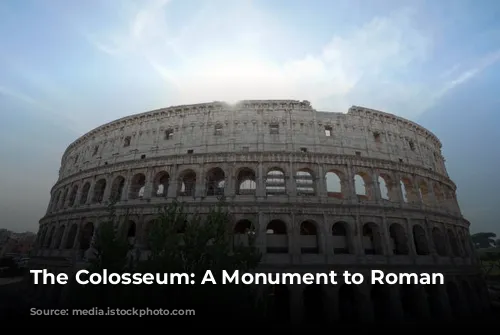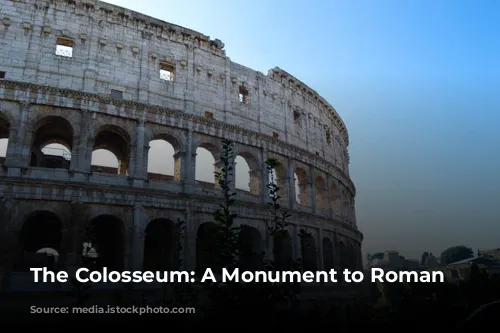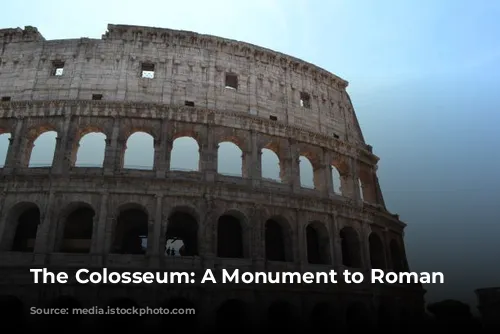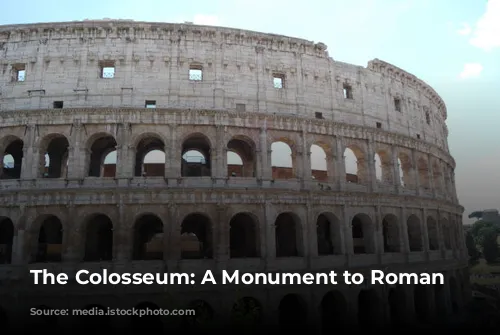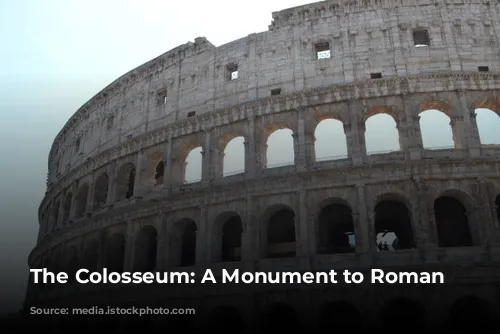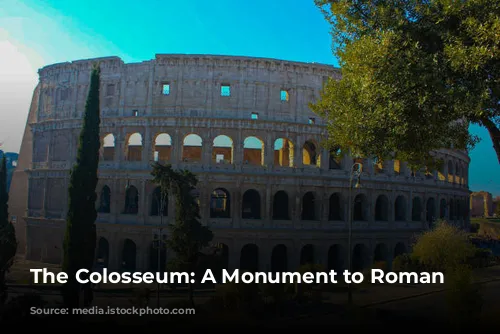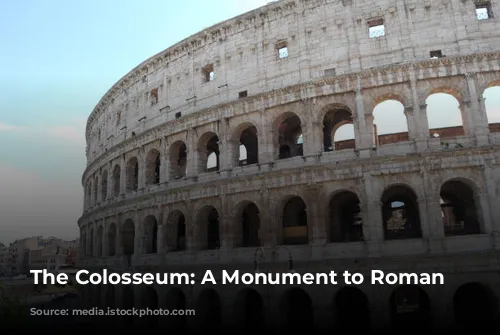The Colosseum, also known as the Flavian Amphitheatre, stands as a testament to the Romans’ incredible architectural prowess and their fascination with spectacle. This massive arena, the largest in the Roman world, was commissioned by Emperor Vespasian of the Flavia family and inaugurated by his son Titus in 80 AD.
A Grand Opening
The Colosseum’s opening ceremony was a lavish spectacle, lasting a remarkable one hundred days! People flocked from all corners of the empire to witness gladiatorial combats, animal hunts, and theatrical performances. The most awe-inspiring event was perhaps the naumachia – staged sea battles that brought the epic naval clashes of the past to life, with the arena floor transformed into a vast, watery stage.
The Colosseum’s Name and Construction
But why is it called the Colosseum?
This name, though widely used today, first appeared in a prophecy by the medieval monk Venerable Bede: “Rome will exist as long as the Colosseum does; when the Colosseum falls so will Rome; when Rome falls so will the world.” The name may have originated from the colossal statue of Emperor Nero, which once stood near the amphitheatre.
An Engineering Marvel
The Colosseum, once a gleaming white structure covered in travertine stone, is a marvel of engineering. Its elliptical shape maximized the space available for spectators. The structure was built in just ten years, a remarkable feat considering its sheer size.
The Romans’ secret? Their mastery of the arch. This architectural element allowed them to distribute the weight of massive structures evenly, forming a perfect balance. Imagine the Colosseum as a series of stacked aqueducts!
A Glimpse into the Colosseum’s Past
Today, we see only the skeletal remains of what was once a grand arena. Its outer brick wall is missing in many parts, a consequence of its use as a source of building materials during the Middle Ages. The marble, lead, and iron extracted from the Colosseum were used to construct the Barberini Palace, Piazza Venezia, and even St. Peter’s Basilica! The holes visible in the Colosseum’s columns are the scars left by the extraction of lead and iron used to fasten the marble blocks.
A Place for the People
The Colosseum was more than just an arena; it was a social space. It could accommodate up to seventy thousand spectators, all enjoying a clear view from their tiered seats, thanks to the ingenious design. Entry was free for Roman citizens, but seating was assigned based on social status, much like modern theatres. The commoners sat in the upper tiers, while the privileged occupied the lower rows, with senators, vestals, priests, and the emperor occupying the front row.
The sun was no problem for these spectators, thanks to the velarium – an enormous linen canopy stretched over the arena using ropes, winches, and wooden poles. One hundred sailors from the Imperial fleet were responsible for moving this massive sail, working in perfect synchrony to the beat of a drum.
The Colosseum’s Spectacles: From Gladiatorial Combat to Animal Hunts
Stepping into the Colosseum, one can almost feel the energy of the gladiatorial combats and the roars of the crowds. The arena floor, once made of brick and wood, has long since vanished, revealing the cellars where gladiators and animals were prepared for their performances.
The underground floors housed hoists and lifts used to bring gladiators and animals into the arena through trapdoors, creating dramatic appearances that would have captivated the crowd. These lifts were also used to raise and lower elaborate backdrops for the animal hunts.
The shows held in the Colosseum were not simply entertainment; they were a means of bonding citizens with their leader. The shows offered a distraction from political problems and fostered a sense of shared experience.
The Colosseum’s Shows: From Animal Hunts to Gladiatorial Combat
The Colosseum’s events were carefully orchestrated. Venationes (animal hunts), often featuring exotic animals, took place in the morning, while the afternoon was reserved for the gladiatorial contests.
**The “silvae” (forest) shows were particularly spectacular, with elaborate scenery that recreated a forest environment, complete with animals. Although the animals were sometimes killed, not all of them met this fate, as evidenced by the famous elephant that learned to write words in the sand.
Contrary to popular belief, the Colosseum was not used for the systematic execution of Christians.
The Gladiators: Warriors, Entertainers, and Celebrities
The gladiators, the stars of the Colosseum, were a diverse group of individuals. They were often prisoners of war, given the choice of slavery or fighting in the arena for a limited time. Some were simply impoverished individuals seeking fame and fortune.
These gladiators were handsomely paid and enjoyed immense popularity, especially among the women. Twelve different types of gladiators existed, each with their unique weaponry and fighting styles.
The gladiators, who often hailed from the Ludus Magnus (gladiator training school), were greeted like heroes upon their entrance into the arena, their arrival heralded by the deafening roar of the crowd. They would pay homage to the emperor, saluting with the famous words: “Ave Caesar, morituri te salutant” (Hail Caesar, those who are about to die salute you).
The fate of the defeated gladiator rested in the hands of the emperor, who could decide their fate with a simple gesture – a thumbs up spared their life, while a thumbs down meant death. The victors were rewarded with golden palm leaves and wealth.
The Romans’ fascination with gladiatorial combat can be compared to our own love for action movies and extreme sports, but with one important difference: the real, unfiltered violence of the Colosseum. The smell of blood, burnt flesh, and wild animals permeated the arena, making it a truly visceral experience.
The Colosseum: A Legacy of Spectacle and Survival
After the decline of the Roman Empire in the 6th century, the Colosseum fell into disuse and its walls were used for various purposes, including housing religious communities, hospitals, and even a cemetery.
In the Middle Ages, the Colosseum was declared a sacred monument dedicated to the Passion of Christ by Pope Benedict XIV, who placed a cross on the structure, marking it as a symbol of the suffering of all Christian martyrs. This cross is still the starting point for the Stations of the Cross during Good Friday.
The Colosseum’s transformation into a sacred site saved it from demolition and ensured its preservation for future generations. Today, it stands as a powerful reminder of the Romans’ grandeur and the enduring fascination with spectacle.
Visiting the Colosseum today is a journey back in time, a chance to “see the ghost of old Rome floating over the places its people walk in,” as Charles Dickens so eloquently described it.
